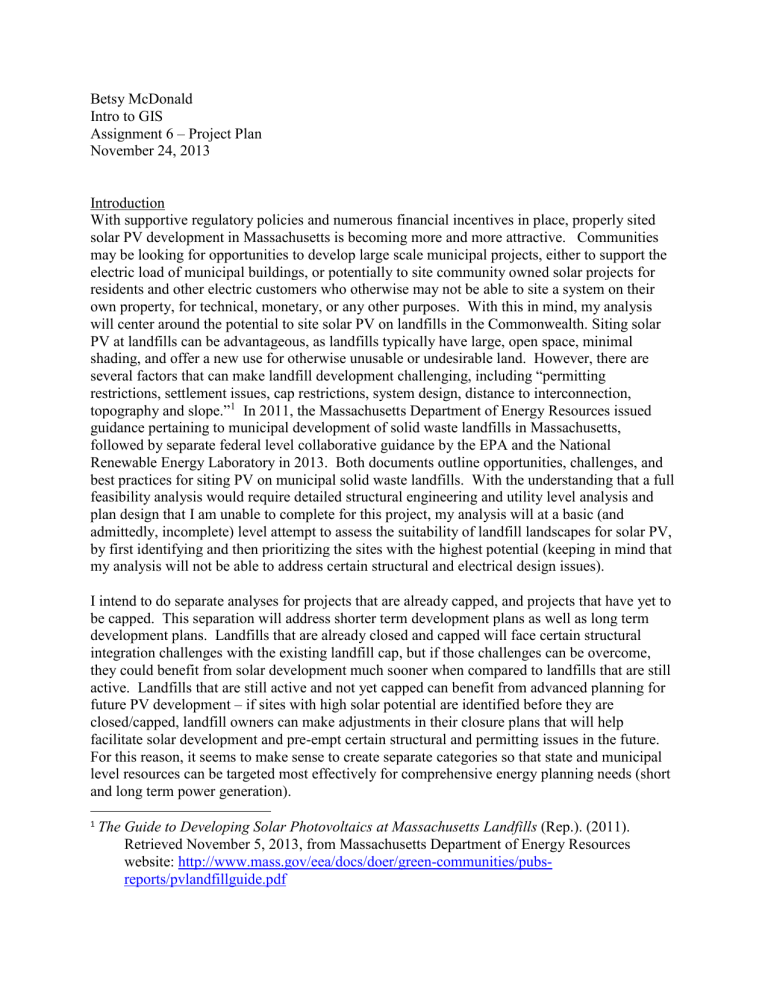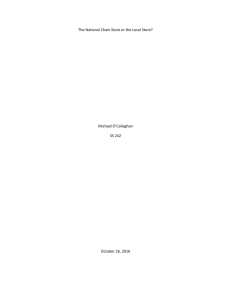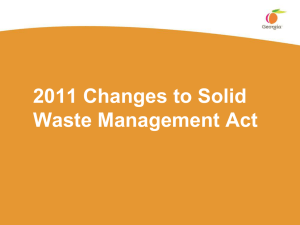Assignment 6

Betsy McDonald
Intro to GIS
Assignment 6 – Project Plan
November 24, 2013
Introduction
With supportive regulatory policies and numerous financial incentives in place, properly sited solar PV development in Massachusetts is becoming more and more attractive. Communities may be looking for opportunities to develop large scale municipal projects, either to support the electric load of municipal buildings, or potentially to site community owned solar projects for residents and other electric customers who otherwise may not be able to site a system on their own property, for technical, monetary, or any other purposes. With this in mind, my analysis will center around the potential to site solar PV on landfills in the Commonwealth. Siting solar
PV at landfills can be advantageous, as landfills typically have large, open space, minimal shading, and offer a new use for otherwise unusable or undesirable land. However, there are several factors that can make landfill development challenging, including “permitting restrictions, settlement issues, cap restrictions, system design, distance to interconnection, topography and slope.” 1
In 2011, the Massachusetts Department of Energy Resources issued guidance pertaining to municipal development of solid waste landfills in Massachusetts, followed by separate federal level collaborative guidance by the EPA and the National
Renewable Energy Laboratory in 2013. Both documents outline opportunities, challenges, and best practices for siting PV on municipal solid waste landfills. With the understanding that a full feasibility analysis would require detailed structural engineering and utility level analysis and plan design that I am unable to complete for this project, my analysis will at a basic (and admittedly, incomplete) level attempt to assess the suitability of landfill landscapes for solar PV, by first identifying and then prioritizing the sites with the highest potential (keeping in mind that my analysis will not be able to address certain structural and electrical design issues).
I intend to do separate analyses for projects that are already capped, and projects that have yet to be capped. This separation will address shorter term development plans as well as long term development plans. Landfills that are already closed and capped will face certain structural integration challenges with the existing landfill cap, but if those challenges can be overcome, they could benefit from solar development much sooner when compared to landfills that are still active. Landfills that are still active and not yet capped can benefit from advanced planning for future PV development – if sites with high solar potential are identified before they are closed/capped, landfill owners can make adjustments in their closure plans that will help facilitate solar development and pre-empt certain structural and permitting issues in the future.
For this reason, it seems to make sense to create separate categories so that state and municipal level resources can be targeted most effectively for comprehensive energy planning needs (short and long term power generation).
1 The Guide to Developing Solar Photovoltaics at Massachusetts Landfills (Rep.). (2011).
Retrieved November 5, 2013, from Massachusetts Department of Energy Resources website: http://www.mass.gov/eea/docs/doer/green-communities/pubsreports/pvlandfillguide.pdf
Spatial Questions
There are several spatial questions that pertain to siting solar PV on landfills. The following spatial questions will be used to create a site prioritization list for landfills that are already capped and may be most suitable for near-term solar PV development, and a site prioritization list for landfills that are still active but may be most suitable for future/long-term solar PV development (and could benefit from pre-emptively modifying their landfill closure plans).
1.
Which landfills currently have large scale solar PV developments onsite, and which landfills already have approved permits for future PV development? (I will want to remove these from consideration, as I want to look at landfills that aren’t yet slated for development).
2.
For existing solid waste landfills (active and inactive/capped) that do not yet have solar onsite, how close are they to utility transmission lines?
3.
How close are existing solid waste landfills (active and inactive/capped) to areas designated as wetlands?
4.
How much solar resource is available at existing landfill facilities? How much shading exists (using canopy cover) onsite?
5.
What is the acreage of the landfill, and what is the average slope for that area?
6.
In which utility territories are high-potential sites located?
7.
Which potential sites are overall most suitable for solar development? (These will be prioritized) Which are least suitable?
Relevant Literature
Arnette, A. N., & Zobel, C. W. (2011). Spatial analysis of renewable energy potential in the greater southern Appalachian mountains. Renewable Energy, 36 , 2785-2798. doi:
10.1016/j.renene.2011.04.024
This article identifies relevant criteria for siting solar facilities, and discusses the use of solar insolation data from NREL, elevation data from USGS, the importance of slope, and land use. The article addresses criticisms of large scale solar PV development, and notes that people may oppose it if it takes up land that could potentially be used for other competing purposes (agriculture, residential/commercial development, etc). As a result of this consideration, the analysis presented in this paper limited the suitable sites to only those identified by NLCD with land covers classified as “barren” (the article considers the “barren” classification to be otherwise unusable for other economic or development purposes). My analysis anticipates a similar criticism but seeks to pre-empt it by only considering landfills and not other spaces or other existing land uses (this isn’t to say that other spaces wouldn’t be appropriate, but rather that I just wanted to prioritize landfills for this assessment, as landfills are already relatively undesirable land uses that could be repurposed through PV development). This article also considered land identified in the
Protected Areas Database for the U.S. The database provides information on whether land is restricted for conservation purposes.
Van Hoesen, J., & Letendre, S. (2010). Evaluating potential renewable energy resources in
Poultney, Vermont: A GIS-based approach to supporting rural community energy planning. Renewable Energy , 35 (9), 2114-2122. Retrieved from http://dx.doi.org.ezproxy.library.tufts.edu/10.1016/j.renene.2010.01.0.
This article looked at development potential for wind, biomass, and solar technologies in a rural town in Vermont. The article is particularly helpful in the detailed methodology – it describes energy potential maps which were created and subsequently used to solicit community input for project development. It also lists the data sources for assessing solar potential including USGS National Elevation Dataset and the National Biomass Carbon
Dataset 2000 (used to assess canopy cover). The methodology also incorporates use of state orthophotos. While I plan to use NLCD data for canopy cover and not the National
Biomass Carbon Dataset, this article still provides a good reference point for developing a systematic assessment of solar potential using GIS.
Janke, J. (2010). Multicriteria GIS modeling of wind and solar farms in Colorado. Renewable
Energy, 35 , 2228-2234. doi: 10.1016/j.renene.2010.03.014
This article does not address landfills in particular, but it does detail a process for assessing large scale wind and solar suitability more generally in Colorado. The article outlines the criteria used for site assessment: renewable potential (using NREL annual insolation data), land cover, population density, distance to roads and transmission lines, and cities. The analysis assigned weights based on importance of the criteria, placing the highest value on solar potential (based on the annual insolation) and proximity to transmission lines. Using the reasoning in this article, I plan to weight these characteristics similarly in my own analysis. I found the population density discussion interesting (siting facilities in areas that are less densely populated), and while I haven’t included population density in my proposal below, I may end up using this as a potential factor for ranking potential landfill development sites.
Kiatreungwattana, K., Mosey, G., Jones-Johnson, S., Dufficy, C., Bourg, J., Conroy, A., ...
Brown, K. (2013, February). Best practices for siting solar photovoltaics on municipal solid waste landfills (Rep.). Retrieved November 20, 2013, from Environmental Protection
Agency website.
This document does not specifically address application of GIS, but it does establish a comprehensive list of criteria that are considered best practices for siting solar PV on landfills. Among the relevant criteria, the article recommends a minimum area of two acres of onsite development capacity, a grade or slope of 2-3% (with an upper maximum of 10%), and a half mile distance to the nearest transmission line (this is the ideal, but the article states that a distance of one to three miles may be acceptable). I plan to use the guidelines established by this document as primary determinants for establishing site prioritization.
Proposed Data
Data Set
Ma s s DEP La nd
Di s pos a l of Sol i d
Wa s te
Communi ty
Bounda ri es
Details Source
SW_LD_PO
LY_LANDFI
LLS
Ma s s GIS
URL http://www.ma s s .gov/a nf/res ea rcha nd-tech/i t-s erv-a nds upport/a ppl i ca ti on-s erv/offi ce-ofgeogra phi c-i nforma ti onma s s gi s /da ta l a yers /s w.html
http://www.ma s s .gov/a nf/res ea rcha nd-tech/i t-s erv-a nds upport/a ppl i ca ti on-s erv/offi ce-ofgeogra phi c-i nforma ti on-
Attributes/Key Features/Notes
Ca p Sta tus , Owners hi p Type,
Acres , Addres s
Town_ID
TOWNS_PO
LY Ma s s GIS
Power Li nes
Di gi ta l El eva ti on
Model (1:5,000)
DEP Wetl a nds
(1:12,000)
TRANSLINE
S_ARC Ma s s GIS
Ma s s GIS
WETLANDS
DEP_POLY Ma s s GIS a nd-tech/i t-s erv-a nds upport/a ppl i ca ti on-s erv/offi ce-ofgeogra phi c-i nforma ti onma s s gi s /da ta l a yers /trns l ns .html
http://www.ma s s .gov/a nf/res ea rcha nd-tech/i t-s erv-a nds upport/a ppl i ca ti on-s erv/offi ce-ofgeogra phi c-i nforma ti onma s s gi s /da ta l a yers /i mgel ev5k.html
http://www.ma s s .gov/a nf/res ea rcha nd-tech/i t-s erv-a nds upport/a ppl i ca ti on-s erv/offi ce-ofgeogra phi c-i nforma ti onma s s gi s /da ta l a yers /depwetl a nds 112
000.html
http://www.ma s s .gov/a nf/res ea rcha nd-tech/i t-s erv-a nds upport/a ppl i ca ti on-s erv/offi ce-ofgeogra phi c-i nforma ti onma s s gi s /da ta l a yers /pubuti l .html
Tra ns mi s s i on l i nes /s ubs ta ti ons
I'l l pri ori ti ze s i tes tha t a ren't wi thi n 100 feet of wetl a nds
(hi ghes t ra nki ng to thos e furthers t from wetl a nds )
El ec (Current el ectri c provi der) -
Ca n a nd pl a n to joi n wi th
TOWNS_POLY on TOWN_ID fi el d
Publ i c Uti l i ty Servi ce
Provi ders
TOWNS_PO
LY_UTILITIE
S Ma s s GIS
MA La ndfi l l Profi l es
(Excel fi l e wi th a ddi ti ona l deta i l s on s ta tus of l a ndfi l l ) l fenergy
La ndfi l l s Wi th Pos t-
Cl os ure Us e Permi ts for Renewa bl e
Energy
Ma s s DEP
Ma s s DEP i ns ol a ti on/s ol a r ra di a ti on da ta ca nopy13_01
1007
NLCD (2001)
Zone 13
NREL http://www.ma s s .gov/eea /a genci es / ma s s dep/s ervi ce/energy/l a ndfi l l s /re newa bl e-energy-projects -a t-cl os edl a ndfi l l s .html
http://www.ma s s .gov/eea /a genci es / ma s s dep/s ervi ce/energy/l a ndfi l l s /l a ndfi l l s -wi th-pos t-cl os ure-us epermi ts -for-renewa bl es .html
http://www.mrl c.gov/fi ndda ta .php
Pos t-Cl os ure Permi t Sta tus , Pos t-
Cl os ure Us e
I need to ma ke thi s a n excel fi l e.
Need a ddres s da ta , onl y i mport where permi t type i s equi va l ent to photovol ta i cs (PV)
Ba rba ra - i t l ooks l i ke the NLCD
2006 da ta does not i ncl ude upda ted da ta for ca nopy cover.
I'm wonderi ng i f I'm mi s s i ng s omethi ng?
http://www.nrel .gov/gi s /da ta _s ol a r.h
tml a nnua l a vera ge s ol a r ra di a ti on
Steps for data creation, processing, and analysis
1.
While many of the data layers are already clipped to Massachusetts, I will need to do preprocessing of certain layers in order to make sure that they are appropriate for my project area (state of Massachusetts). This applies to the NREL insolation data and canopy cover data, both of which will also need to be projected to
NAD_1983_StatePlane_Massachusetts_Mainland_FIPS_2001. The other MassGIS data layers will already be in this projection).
2.
I will need to select by attribute to remove unnecessary fields from my transmission line data set in order to make sure that I am only looking at proximity to power lines and sub stations (and not the ski lifts, landing strips, and airports, etc. that are in the original dataset).
3.
I will need to bring in excel tables from the two datasets I have from MassDEP and join them to the municipal solid waste landfill site data set I have from MassGIS. The
MassDEP data provides important details about which sites already have PV onsite, and which sites have been permitted for other uses.
4.
Once I have all of the DEP data joined to the solid waste landfill data, I will need to refine this data set to meet some additional basic criteria. I need to select by attribute and remove all the sites that already have PV onsite, as I don’t want to consider/assess these for future development. I also want to remove landfills that have been capped and already have other uses (ie some have been slated for soccer fields, parking garages). I also want to select by attribute to remove all landfills that are under 2 acres in area (as this is the minimum area recommended for site development).
5.
I plan to use the Select by Location feature to remove landfills that are more than 3 miles from transmission lines, as this is the maximum distance recommended (when I do the suitability analysis I will give higher value to those that have transmission lines the closest, but I don’t even really want to consider landfills that have lines further away than
3 miles).
6.
After I have pared down the landfill data, I want to create two separate data layers – one that has only closed/capped landfills, and one that has only active (and inactive but uncapped) landfills. I want to assess suitability for these two categories separately.
7.
Using a process similar to what is detailed in some of the suitability reports as well as the exercise we did in class for siting wind facilities in Beijing, I want to reclassify canopy cover, insolation data, DEM data (to get to slope – low slope is preferable), proximity to transmission lines, and proximity to wetlands, and then create preference grids for each of these based on the criteria I found in the peer-reviewed articles, the Department of
Energy Resources report, and the EPA report. Note: I may want to include a category for distance from cities with high population densities, with higher priority going to sites that are located more remotely / further from major cities/populations. If I were to do this, I would use Census data for population densities. I haven’t decided whether to do this yet, though, as part of the community solar idea is that it would allow people who can’t go
solar themselves to participate, and you would have to be located within the same utility load zone as the project to participate (in which case you wouldn’t necessarily want to be too far away, or at least the idea that “further away is better” may not necessarily be true).
8.
Next, I want to perform an overlay of the reclassified data sets in order to create final suitability zones (I will probably weight proximity to transmission lines, canopy cover, and insolation data slightly more than the others). I think (although this might not be the best way to do it?) I will do this for the whole state, and then use zonal statistics as a table tool to get a mean score for the land area in each landfill polygon. This will help identify the top sites for both capped (near term potential for PV) and uncapped landfills (future potential for PV, once the landfill closes). For the top sites, I also want to visually check canopy coverage against aerial photos to make sure that the canopy data was accurate, within reason.
Products to include on poster
As of now, in addition to the text that introduces my project and spatial questions and explains my methodology, process, and results, I plan to include several different visuals in the final poster. I want to first include a map that shows which landfills currently have PV, a map which shows which active/uncapped landfills were the best suited (perhaps the top 10?) for future/longer term PV development, as well as a map that shows which closed/capped landfills are best suited for more immediate solar development (again, perhaps the top 10). It might also be interesting to include close up comparisons of my suitability assessment for a particularly well-suited site with an aerial image of the actual site. I also anticipate that I’ll have a table, graph (or a couple) explaining how the different criteria were reclassified, which standards I used to prioritize different categories, etc.







